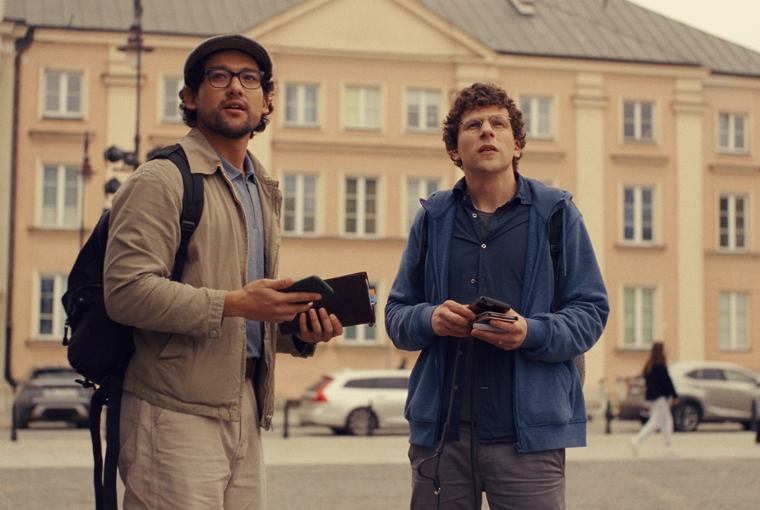Reason, Passion, and the Face of Memory
Jesse Eisenberg’s A Real Pain (2024)
Vol. 156 (Summer 2025) by Moritz Pfeifer
In hindsight, the ongoing genocide against Palestinians makes it seem strange that the Holocaust representations of the last decade have become more and more abstract. Instead of understanding the event in terms of human suffering, filmmakers have grappled with theories of representation. At the heart of these theories lies a paradox. How is it possible to remember something that was meant to be forgotten? Adorno’s famous dictum that “to write poetry after Auschwitz is barbaric” captured the postwar angst that art might beautify or diminish the horror of the camps. Writing decades later, Georges Didi-Huberman countered this with his call for “images in spite of all.” He argued that even fragmentary traces, like the few photographs taken inside Auschwitz-Birkenau, demand to be seen. Together, they marked two poles in the debate over whether the Holocaust can or should be represented. Less academic formulations of this debate run through society. Think, for instance, about the cognitive dissonance schoolchildren face when reading Anne Frank’s diary and being told that they have some kind of duty not to understand it.
Almost all major films of the last decade that deal with the Holocaust and remembrance are attempts to reconciliate these opposing views of showing without showing, of understanding in the face of incomprehensibility. Paweł Pawlikowski’s Ida (2013) focuses on the absence of Jewish life in post-war Catholic Poland; László Nemes’ Son of Saul (2015) offers an immersion in Auschwitz, but the camp is never seen; Sergei Loznitsa’s Austerlitz (2016) observes tourists at Sachsenhausen and Dachau as a commentary on black tourism; and Radu Jude’s Barbarians (2018) shows how governments instrumentalize “remembering” for nationalist politics. While completely different in style and scope, all of these films turn the memory of the Holocaust into an abstract problem of how to represent the event without betraying its aniconic weight.
Jesse Eisenberg’s A Real Pain, while perhaps not entirely abstaining from the Holocaust representation debates, at least offers a new argument, although calling it an “argument” would do the movie injustice since it moves away from reasons and toward feelings. A Real Pain follows two estranged American cousins, David (Jesse Eisenberg) and Benji (Kieran Culkin), who reunite for a Holocaust-themed heritage tour in Poland after their grandmother’s death. As they travel through Warsaw and visit sites tied to Jewish memory and destruction, their clashing personalities turn the journey into a reckoning with grief, family history, and the burden of memory. The film’s message, or anti-message, is to return to feeling, letting emotions like grief, shame, and humor do the work that theory and abstraction cannot.
Reason and Passion
David lives in New York City with his wife and kid and works in digital ad sales. Like his cousin Benj, and about one in three white US-Americans, David is in pain.1 Unlike Benji, David is out of touch with his emotions. He confesses that his habits for “moving forward” are taking pills, jogging, meditation, and work; a strict routine that keeps sorrow contained. Rationalization may also provide solace. David knows where his pain is coming from. He has OCD, the diagnosis making the suffering more manageable.
Benji is out of work, and lives alone upstate in Binghamton. He has recently tried to take his own life. Benji feels in the moment. He never names his pain but is unafraid of his own feelings. Naturally, each character longs for what the other has but the pull also unsettles them, because it throws their own way of living into question. To Benji, David is like a “brother” but also “just part of a fucked-up system.” David envies Benji for his charisma yet compares him to someone in “their mother’s basement smoking pot all day.”
In their opposition, David and Benji echo literary archetypes of reason and passion, what Nietzsche described as the pull between the Apollonian and the Dionysian in The Birth of Tragedy. The film’s score also reflects this divide. It leans heavily on Chopin’s waltzes and nocturnes. The waltzes, in steady triple meter, play like masks over emotion, echoing David’s drive to manage sorrow with form. With their ornamental structure, the waltzes carry traces of bourgeois social life, elegant in form but hollowed by the conventions of the salon. Chopin’s nocturnes, on the other hand, are truer to subjectivity. With their free time and lyrical inwardness, they capture Benji’s fragile, solitary self and an interior voice that resists social function.
Trauma and Reenactment
David and Benji’s personalities reflect two contrasting ways of responding to trauma. One sequence in Eisenberg’s film dramatizes Holocaust remembrance as a confrontation between feeling and abstraction. On the train to Lublin, near the former Majdanek camp, Benji is unsettled by the incongruity of riding first-class on a Holocaust tour and opens a conversation with the group. Embarrassed, David tries to stop his cousin, brushing off Benji’s feelings as inappropriate and depressing, but this only heightens Benji’s anxiety. Benji then leaves the group to sit second-class and David follows. When David falls asleep and Benji remains awake beside him, they switch characters. Benji steps into the role of the caretaker and decision-maker, eventually plotting their illicit return trip to Lublin. David’s sleep is a surrender of control that lets grief slip past his conscious barriers. During the return trip, he finally gives in to thrill and danger. Where David had questioned his cousin’s insistence on “feeling” during the conversation with the group, he now experiences panic, exhilaration, and release. When they land again in first class and David bursts out, “We made it!”, a nostalgic smile reconnects him with the boy that Benji had remembered from their childhood earlier in the sequence.
Reenactment is considered an important form of working through trauma that is elaborated in contemporary trauma studies as both a symptom and, under therapeutic containment, a path to healing.2 Literary trauma theory has extended this idea into the field of representation. For example, Cathy Caruth has argued that trauma resists rational comprehension, surfacing instead as belated, intrusive affect that “speaks through” the subject rather than being consciously narrated.3 Dominick LaCapra reframed this in terms of acting out and working through: the first a compulsive repetition where affect dominates, the second a mediated process where reason engages emotion without cancelling it.4 In other words, remembrance requires both Benji and David: acknowledging the pull of feeling while preserving the rational distance needed for critical engagement.
On a meta-level, Eisenberg’s film can be read as a critique of Holocaust cinema, where, as with David’s OCD, control has taken precedence over affect. The overemphasis on the theoretical problems of representation described above has pushed filmmakers into turning the catastrophe into a formal exercise rather than an event that still provokes feelings. Nietzsche cautioned that such efforts at intellectual self-mastery risk sliding into “bad conscience,” where reflection becomes a form of self-punishment and the pain that should be faced is pushed further away. Holocaust reenactment in this sense is about reopening the channel of affect that abstraction has sealed. Many viewers may cry at some point during the film, perhaps wondering with Benji when was the last time they were “so emotional.”
The Face of Memory
The film opens and closes on Benji’s face, who is sitting alone in a crowd at the airport. In the first airport scene, the camera finds Benji in a crowd of anonymous travelers. His expression is melancholic, and he appears isolated. The title, “A Real Pain,” appears next to his face. The viewer is immediately confronted with Benji’s vulnerability, establishing the film’s focus. The final scene returns to this image, but the context has changed. Benji again sits alone, but after the journey through Poland, his face now carries the weight of his experiences in Poland. He looks at the strangers around him. The script reads, “Anyone can be a friend.”
The French philosopher Emmanuel Levinas, whose work was shaped by the Holocaust, argued that seeing another person’s face creates an ethical obligation. In Totality and Infinity (1961) he places the encounter with another person at the very beginning of ethical thought. Where philosophers like Immanuel Kant had grounded morality in reason and universal law, Levinas argued that responsibility comes first in the immediate relation to the other. For Levinas, the face of another is vulnerable and makes a fundamental demand: “Do not kill me.” Ethics does not begin with theoretical reflection but with the exposed presence of another human being. Levinas’ thought hangs over Benji’s face in the film’s opening and closing images. His pain does not ask to be explained but to be recognized. As for the representability debate, this means that remembering the Holocaust may be less about grappling with the limits of what can be shown, than about confronting ethical demands. How do we relate to the pain of others? In the present, where the Holocaust is instrumentalized to legitimize the destruction of Palestinian lives, Eisenberg’s insistence on affect over abstraction points toward what is missing in the public discourse. Memory, if it is to have any value, demands seeing the faces of those whose lives are considered ungrievable today.
- Lucas, J. W., & Sohi, I. (2024). Chronic Pain and High-impact Chronic Pain in U.S. Adults. NCHS Data Brief No. 518. https://www.cdc.gov/nchs/products/databriefs/db518.htm ↩︎
- See e.g. Herman, J. L. (1992). Trauma and recovery. New York: Basic Books; van der Kolk, B. (2014). The body keeps the score. New York: Viking. ↩︎
- Caruth, C. (2016). Unclaimed experience: Trauma, narrative, and history. Johns Hopkins University Press. ↩︎
- LaCapra, D. (2014). Writing history, writing trauma. Johns Hopkins University Press. ↩︎




Leave a Comment